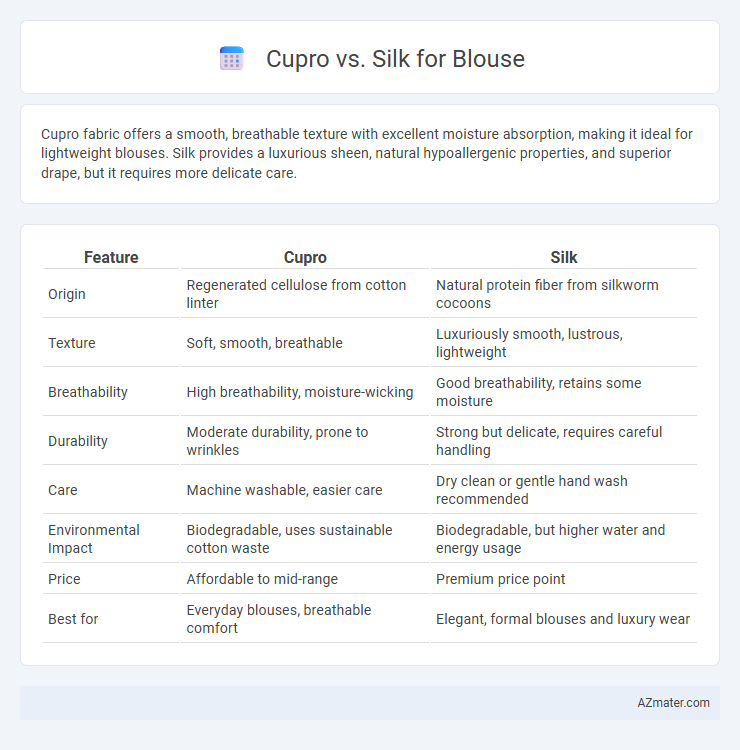Cupro fabric offers a smooth, breathable texture with excellent moisture absorption, making it ideal for lightweight blouses. Silk provides a luxurious sheen, natural hypoallergenic properties, and superior drape, but it requires more delicate care.
Table of Comparison
| Feature | Cupro | Silk |
|---|---|---|
| Origin | Regenerated cellulose from cotton linter | Natural protein fiber from silkworm cocoons |
| Texture | Soft, smooth, breathable | Luxuriously smooth, lustrous, lightweight |
| Breathability | High breathability, moisture-wicking | Good breathability, retains some moisture |
| Durability | Moderate durability, prone to wrinkles | Strong but delicate, requires careful handling |
| Care | Machine washable, easier care | Dry clean or gentle hand wash recommended |
| Environmental Impact | Biodegradable, uses sustainable cotton waste | Biodegradable, but higher water and energy usage |
| Price | Affordable to mid-range | Premium price point |
| Best for | Everyday blouses, breathable comfort | Elegant, formal blouses and luxury wear |
Introduction to Cupro and Silk Fabrics
Cupro fabric, derived from regenerated cellulose fibers extracted from cotton linter, offers a smooth, breathable texture ideal for blouses, showcasing excellent moisture-wicking properties. Silk, a natural protein fiber produced by silkworms, is prized for its luxurious sheen, soft hand feel, and temperature-regulating qualities. Both fabrics provide distinct tactile experiences and performance characteristics, making them popular choices in high-end blouse materials.
Origins and Production Processes
Cupro is a regenerated cellulose fiber derived from cotton linter, a byproduct of cotton production, processed through a chemical-intensive method involving treatment with copper salts and ammonia. Silk originates from the natural protein fiber produced by silkworms during cocoon formation, harvested through a labor-intensive process of boiling cocoons to extract continuous filaments. While Cupro's production emphasizes industrial chemical processing to transform plant fibers, silk relies on traditional sericulture encompassing cultivation, harvesting, and reeling of silk threads.
Texture and Feel: Cupro vs Silk
Cupro offers a smooth, breathable texture with a subtle sheen, often feeling cooler and softer against the skin compared to silk. Silk boasts a luxurious, naturally glossy finish and a lightweight, smooth feel that drapes elegantly but may trap heat more than cupro. Both fabrics provide exceptional comfort, but cupro's moisture-wicking properties make it preferable for warm climates, whereas silk excels in creating a rich, sophisticated touch.
Breathability and Comfort Comparison
Cupro fabric offers superior breathability due to its moisture-wicking properties and natural cellulose fiber composition, making it ideal for hot and humid conditions. Silk, while luxurious and smooth, tends to trap heat and absorb moisture more slowly, which can reduce overall comfort in warm weather. The soft drape of cupro enhances airflow, making it a more comfortable choice for blouses worn throughout the day.
Durability and Longevity
Cupro offers superior durability compared to silk, resisting wear and tear while maintaining its softness and sheen over time. Silk, though luxurious and elegant, is more delicate and prone to damage from abrasion and exposure to sunlight, reducing its longevity. For a blouse designed to last through frequent wear, cupro provides a practical yet stylish alternative with enhanced durability.
Sustainability and Eco-Friendliness
Cupro, a regenerated cellulose fiber made from cotton linter, offers a sustainable alternative to traditional fabrics due to its biodegradable nature and use of cotton waste, reducing textile industry pollution. Silk, while biodegradable and naturally sourced from silkworms, raises concerns about ethical production and environmental impact related to water and pesticide use in mulberry cultivation. Cupro's closed-loop production process recycles chemicals and water, making it more eco-friendly compared to conventional silk farming, which often lacks such sustainability measures.
Care and Maintenance Requirements
Cupro blouses require gentle hand washing or delicate machine cycles with mild detergent to maintain their softness and prevent shrinkage, while silk blouses demand even more careful handling, often needing dry cleaning or hand washing in cold water to preserve their natural sheen and avoid damage. Both fabrics should be air dried flat, away from direct sunlight to prevent color fading, with silk benefiting from a silk-friendly fabric conditioner to maintain its luster. Ironing cupro requires a low heat setting, ideally with a cloth barrier, whereas silk requires very low heat or steaming to avoid burns and maintain the fabric's integrity.
Price Differences and Affordability
Cupro fabric generally costs significantly less than silk, making it a more affordable choice for blouse materials. While silk is valued for its natural luxury, softness, and sheen, its production and demand contribute to a higher price point that can double or triple the cost of cupro. Cupro offers a cost-effective alternative with similar draping qualities, appealing to budget-conscious consumers seeking elegance without the premium price tag of silk.
Style and Aesthetic Appeal
Cupro offers a smooth, matte finish that drapes elegantly, lending a modern, minimalist aesthetic to blouses. Silk provides a natural sheen and fluidity, creating a luxurious and timeless look ideal for sophisticated or formal styles. Both fabrics enhance blouse appeal through their unique textures, with cupro favoring understated elegance and silk emphasizing classic opulence.
Which is Better for Blouses?
Cupro offers a smooth, breathable texture with excellent moisture-wicking properties, making it ideal for lightweight, comfortable blouses suitable for warm weather. Silk provides a luxurious sheen and natural hypoallergenic qualities, but it requires delicate care and is less breathable compared to cupro. For blouses prioritizing durability, ease of maintenance, and breathability, cupro is often the better choice, while silk is preferred for elegance and softness in special occasions.

Infographic: Cupro vs Silk for Blouse
 azmater.com
azmater.com